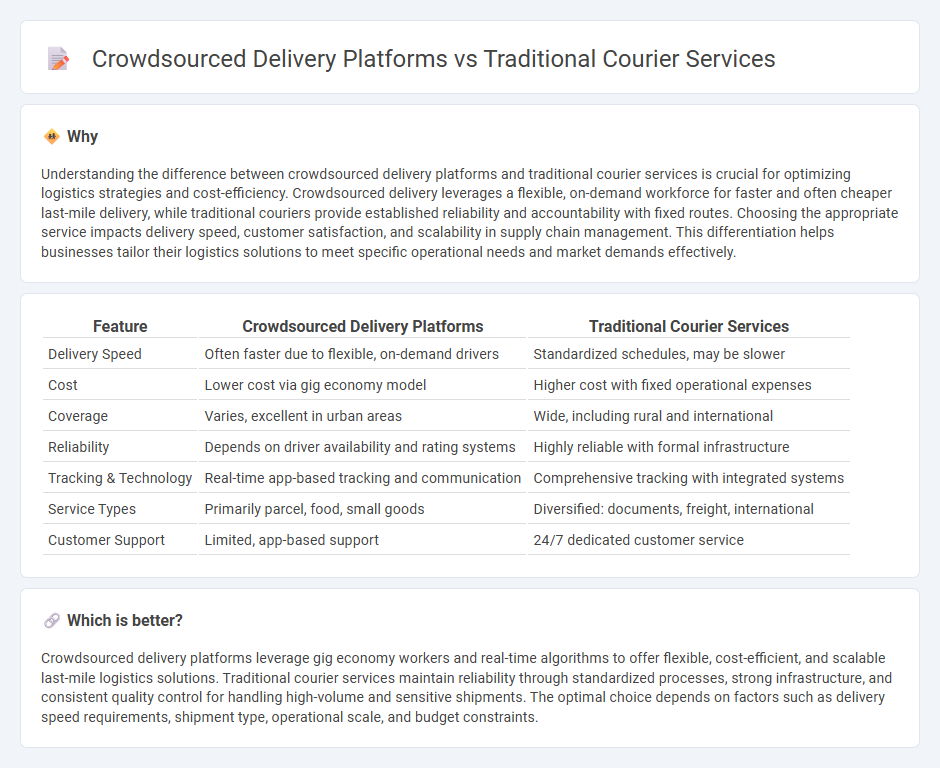
Crowdsourced delivery platforms leverage a decentralized network of independent drivers to enhance flexibility and reduce costs, offering real-time tracking and rapid local deliveries compared to traditional courier services reliant on fixed routes and schedules. These platforms utilize advanced algorithms and mobile technology to optimize route efficiency and adapt dynamically to demand fluctuations, contrasting with the conventional logistic models that often involve centralized hubs and longer delivery times. Discover how these innovative delivery solutions can transform your logistics strategy and improve customer satisfaction.
Why it is important
Understanding the difference between crowdsourced delivery platforms and traditional courier services is crucial for optimizing logistics strategies and cost-efficiency. Crowdsourced delivery leverages a flexible, on-demand workforce for faster and often cheaper last-mile delivery, while traditional couriers provide established reliability and accountability with fixed routes. Choosing the appropriate service impacts delivery speed, customer satisfaction, and scalability in supply chain management. This differentiation helps businesses tailor their logistics solutions to meet specific operational needs and market demands effectively.
Comparison Table
| Feature | Crowdsourced Delivery Platforms | Traditional Courier Services |
|---|---|---|
| Delivery Speed | Often faster due to flexible, on-demand drivers | Standardized schedules, may be slower |
| Cost | Lower cost via gig economy model | Higher cost with fixed operational expenses |
| Coverage | Varies, excellent in urban areas | Wide, including rural and international |
| Reliability | Depends on driver availability and rating systems | Highly reliable with formal infrastructure |
| Tracking & Technology | Real-time app-based tracking and communication | Comprehensive tracking with integrated systems |
| Service Types | Primarily parcel, food, small goods | Diversified: documents, freight, international |
| Customer Support | Limited, app-based support | 24/7 dedicated customer service |
Which is better?
Crowdsourced delivery platforms leverage gig economy workers and real-time algorithms to offer flexible, cost-efficient, and scalable last-mile logistics solutions. Traditional courier services maintain reliability through standardized processes, strong infrastructure, and consistent quality control for handling high-volume and sensitive shipments. The optimal choice depends on factors such as delivery speed requirements, shipment type, operational scale, and budget constraints.
Connection
Crowdsourced delivery platforms leverage the extensive networks of traditional courier services to enhance last-mile logistics efficiency and scalability. These hybrid models optimize route planning and real-time tracking by integrating crowdsourced drivers with established courier infrastructure, reducing delivery times and operational costs. Data analytics and API connectivity facilitate seamless coordination between both systems, improving customer satisfaction and service reliability.
Key Terms
**Traditional Courier Services:**
Traditional courier services offer reliable, scheduled deliveries with established networks and standardized pricing models. They prioritize security and package handling through well-trained personnel and insured transport, ensuring consistent service quality. Discover how these strengths compare to innovative crowdsourced delivery platforms.
Fixed Routing
Traditional courier services utilize fixed routing with predetermined schedules and specific delivery zones, ensuring reliability and predictability in operations but often limiting flexibility and speed. Crowdsourced delivery platforms leverage dynamic routing driven by real-time demand and location data, optimizing efficiency and reducing delivery times through a flexible, scalable network of independent drivers. Explore how fixed routing impacts cost-efficiency and customer satisfaction in both models to make informed logistical decisions.
Fleet Ownership
Traditional courier services rely heavily on owning and managing their own fleets, ensuring control over delivery schedules, vehicle maintenance, and branding consistency. Crowdsourced delivery platforms, in contrast, operate using independent drivers' vehicles, reducing overhead costs and enabling scalable, flexible delivery networks without direct fleet ownership. Explore how fleet ownership models impact efficiency, cost, and service quality in modern delivery solutions.
Source and External Links
Online Delivery vs. Traditional Courier Services: Choosing the Right Option - Traditional courier services involve manual shipping with personalized, face-to-face service at physical locations, appealing to those valuing reliability and direct customer interaction, though they can be slower and less tech-enabled than online options.
Types of Courier Services [2025 Guide] - Traditional courier services operate fleets of vehicles for transporting goods locally or globally, offering last-mile delivery with options ranging from local city-wide to international shipping, and include companies like DHL, FedEx, and local providers.
Courier - Wikipedia - Traditional couriers have evolved from localized riders and taxi-based delivery to large networks providing same-day and next-day services, with many freelance and "man & van" models, especially prevalent in the UK, adapting to changing document and parcel needs over time.
 dowidth.com
dowidth.com